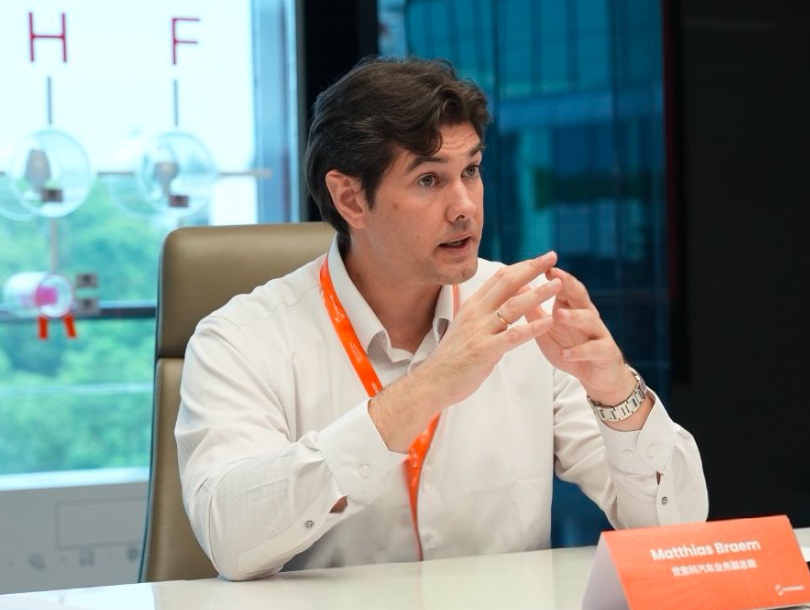Global chemical giant solvay sees potential in new materials for power batteries
The multinational chemical materials giant Solvay recently released its Q2 2025 financial report, showing that thanks to the performance of its specialty polymers business, the company’s adjusted EBITDA (earnings before interest, taxes, depreciation, and amortization) for the second quarter was approximately €1.3 billion, an 8% increase quarter-on-quarter from Q1.
In the business structure of Solvay, one of the main market applications for its specialty polymers is in power batteries. In May 2025, the company announced that it had signed multi-year agreements with several automotive manufacturers and battery producers, with a total value exceeding 150 million euros, to supply them with battery-grade Solef® PVDF (polyvinylidene fluoride).
Matthias Braem, Vice President of Automotive Business at SESOKO, recently stated in an interview with 21st Century Business Herald: "In my opinion,In the current Chinese market, the "involution" of the new energy vehicle or power battery industry is moving forward and advancing. Consumers determine what kind of products the market needs and lead us on the path of innovation.
Despite the intense industry competition, Matthias Braem remains very optimistic about the demand for new materials driven by power batteries. Even in the currently highly competitive Chinese market, SGL Carbon is committed to deepening its localization strategy.
“We have a complete set of localized closed-loop measures.” Matthias Braem told the 21st Century Business Herald reporter that the company has deployed many local resources in the Chinese market to provide localized technical service support: from localized manufacturing at the Changshu factory to localized talent development, the company has built a flat organizational structure for localized operations.
In fact, under the trend of automotive electrification, the Chinese new energy vehicle market has generated new demands for battery packs and cell materials for power batteries.

"Currently, the Chinese new energy vehicle market favors battery packs with larger capacities and batteries with faster charging speeds." In response to this trend, Matthias Braem told a reporter from 21st Century Business Herald that this involves three challenges: "How to expand battery pack capacity, achieve efficient thermal management, and balance size."
For example, products launched by Matthias Braem at Solvay include Amodel® PPA or Ryton® PPS materials, which can be used in thin-wall designs to achieve lightweight components, while the Xencor™ series of PPA materials, thanks to their excellent mechanical properties, can be applied to complex part designs, significantly saving space.
It should be noted that the safety of new energy vehicle batteries is the premise of all requirements. Even if the materials of future battery packs become increasingly lightweight, they will not contradict safety requirements. "The fire resistance of a battery is not related to its weight, but depends on the type of material. For instance, materials like Xencor™ XTreme inherently have resistance to extreme high temperatures above 1000 degrees, which enables them to effectively prevent the spread of flames," explained Matthias Braem.
Matthias Braem clearly feels that China is becoming a hub of innovation for many advanced new materials due to the rapid changes in the Chinese new energy vehicle market and the power battery market.
For example, in the Chinese market, the technological reserves in solid-state batteries and nano batteries have enabled SESOKO, as a foreign enterprise in China, to proactively anticipate industry development trends.
In this process, Sysco hopes to maintain predictability and proactivity in the supply chain with Chinese companies.
“China is already in a leading position in many fields, which enables Seco to gain deeper insights into technology, connect with talent, and support Chinese OEMs and secondary suppliers in expanding overseas,” Matthias Braem told the 21st Century Business Herald reporter.
According to Matthias Braem's observation:Chinese companies going global typically choose between two strategic directions: one is to continue focusing on domestic manufacturing and increase exports; the other is to consider setting up overseas manufacturing. Establishing overseas manufacturing has lower geopolitical and logistical risks, and there is good synergy between costs and pricing, making it more resilient and sustainable.
"As a global enterprise with deep roots in various regions, we have a well-established local R&D and supply system, and a profound understanding of local customers and market demands. These capabilities enable SSOE to assist Chinese companies in going global and help them develop products that meet local market needs," said Matthias Braem.
【Copyright and Disclaimer】The above information is collected and organized by PlastMatch. The copyright belongs to the original author. This article is reprinted for the purpose of providing more information, and it does not imply that PlastMatch endorses the views expressed in the article or guarantees its accuracy. If there are any errors in the source attribution or if your legitimate rights have been infringed, please contact us, and we will promptly correct or remove the content. If other media, websites, or individuals use the aforementioned content, they must clearly indicate the original source and origin of the work and assume legal responsibility on their own.
Most Popular
-

EVA Morning Prices on September 12: Most of the Market Holds Steady, Highest Rise of 50 Yuan
-

[PET Weekly Outlook] Polyester Bottle Chips Expected to Oscillate and Warm Up with Costs Today
-

Top Ten Personnel Changes in the Auto Industry: Insights into Industry Anxiety and Progress | Vision 2025
-

Domo Chemicals Files for Bankruptcy Protection in Germany! B. Braun Launches New Supply Assurance Program
-

List Released! Mexico Announces 50% Tariff On 1,371 China Product Categories






